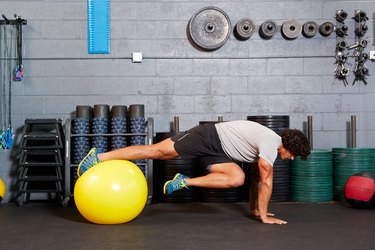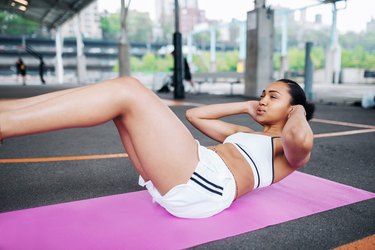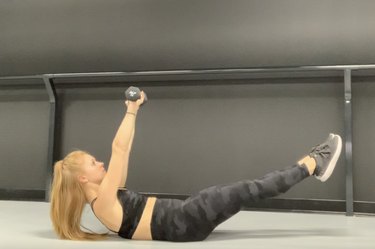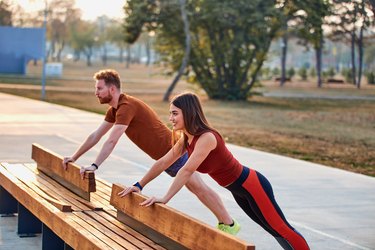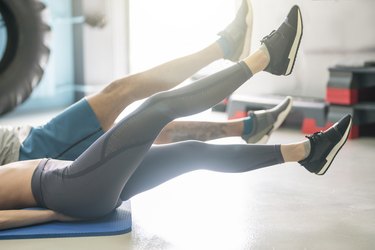

With so many ab exercises to choose from, some are bound to get lost in the shuffle. However, there's one you should be sure to keep track of: flutter kicks.
"They're a low-impact exercise that can be done anywhere with minimal equipment and space," says Brett Durney, CPT, co-founder of Fitness Lab boutique gyms in London.
Video of the Day
What's more, they hit your abs from many angles, helping you build a rock-solid midsection from the inside-out. And if you're not ready for the traditional version (yet), there are ways to modify flutter kicks to fit your body.
Here's everything you need to know to nail this awesome ab exercise.
- What is a flutter kick? This challenging ab exercise can be spotted in many Pilates classes and strength routines. You perform the move by lying on your back, lifting your legs off the ground and "fluttering" your feet in an up-down motion.
- What muscles does the flutter kick work? This abs strengthener target your rectus abdominis (six-pack muscles) as well as your deep-lying transverse abdominis and obliques for stabilization. They also train the lower back, hip flexors and quadriceps, says Jody Braverman, CPT, a certified personal trainer and weight-loss coach
- Who can do flutter kicks? They are generally safe and accessible, though there are groups who may want to find an alternate core exercise. People who are pregnant or have back pain should avoid this exercise unless their doctor or physical therapist has given them the go-ahead.
How to Do Flutter Kicks
Nailing flutter kick form is critical to really engaging your abs and keeping stress out of your lower back. Here, Daniel Richter, CPT, powerlifting trainer and co-founder of StrengthLog, show's how it's done.
Flutter Kicks
- Lie on your back on the floor with your legs extended and your arms alongside your hips, palms down. Or, place your hands under your glutes or lower back if you need help stabilizing your core.
- Push your lower back into the floor (or your hands, if they’re under your lower back) to help engage your core.
- Lift your legs 4 to 6 inches off the floor. Squeeze your abs to keep your back from arching.
- Keeping your legs straight, slowly lift one leg higher, and then switch legs. Move in a fluttering, up-and-down motion.
- Perform 15 to 20 repetitions. Alternatively, do the exercise for a certain amount of time, such as 20 to 30 seconds.
Tip
To make this exercise easier, simply keep your legs positioned closer to the ceiling, Braverman says. The lower you move your legs, the harder the exercise becomes.
2 Awesome Flutter Kick Benefits
1. They Build a Strong Core
The motions may be small, but you're building serious core strength and stability with this abs move. "The up-and-down motion has your abs working hard to control your legs, pelvis and core," Richter explains.
Plus, simply holding both legs off the ground takes a good amount of core strength. And a strong core offers many benefits, including injury prevention, improved posture, and greater stability and balance, Durney says.
Flutters are especially great at hitting the lower portion of your ab muscles, an area many moves like crunches and planks don't hit as much.
2. They Loosen Up Tight Hips
Some folks worry that performing ab exercises like flutter kicks results in tight hip flexors. But when it comes to tight hips, hip flexor-strengthening exercises like kicks aren't necessarily the problem. They might be part of the solution.
Working your hip flexors increases blood flow to the muscles, helping to make them warm and pliable, Durney says. This can help improve hip mobility and ease tightness.
Are Flutter Kicks Safe for Your Back?
When done correctly, they're a back-friendly abs exercise that can actually strengthen all the tiny muscles that stabilize the lower back, Braverman says.
However, if you lack the abdominal strength needed to pull it off with great form, your lower back may try to pick up the slack, which can cause discomfort or pain over time.
If your lower back arches off of the floor during the exercise, you're likely putting excess stress on the area, says certified Pilates instructor Kaleen Canevari, founder and CEO of Flexia Pilates.
If that happens, try modifying the exercise. You can raise your legs higher, only lift one leg off the floor at a time or try bent-leg reps. (See the section on modifications for demo videos.)
Flutter Kicks vs. Scissor Kicks: What's the Difference?
Flutter kicks are sometimes referred to as scissor kicks. But they aren't quite the same thing.
Scissors have one key difference that sets them apart from flutters: widening the legs into a "V" shape before bringing them together and crossing one leg over the other.
So, instead of fluttering your feet up and down throughout your set, scissor kicks involve alternating that "V" shape with crossing one leg over the other, making sure to alternate which leg crosses over the top.
Thankfully, there isn't much difference between flutter kicks and scissors, as they essentially work the same muscles. "There may be some small stabilizer muscles that are more active in scissor kicks, but it's going to be minimal," Braverman says.
2 Modifications to Make Them Easier
Move 1: Bent-Knee
Cab't do flutter kicks? If you have a hard time keeping your back from arching, perform the move from a bent-leg position instead, Durney says. Over time, you can straighten your knees bit by bit.
Move 2: Single-Leg
Here's another great way for beginners to do flutter kicks, By keeping one heel on the floor at all times, you wind up lifting only half the weight you do with standard reps. Plus, you don't need to work as hard to stabilize your lower body, Richter says.
2 Progressions to Make Them Harder
Move 1: Ankle-Weight
To make the exercise more challenging, simply add some ankle weights. Thanks to the extra weight coming through your legs, your core will have to work harder to keep everything in place, Durney says. Start with light ankle weights — 1 pound per side should do it, Richter says — and progress from there.
Move 2: Overhead-Weighted
Holding a weight overhead lengthens your core muscles, and increases the amount of work on your upper abs, Durney says.
